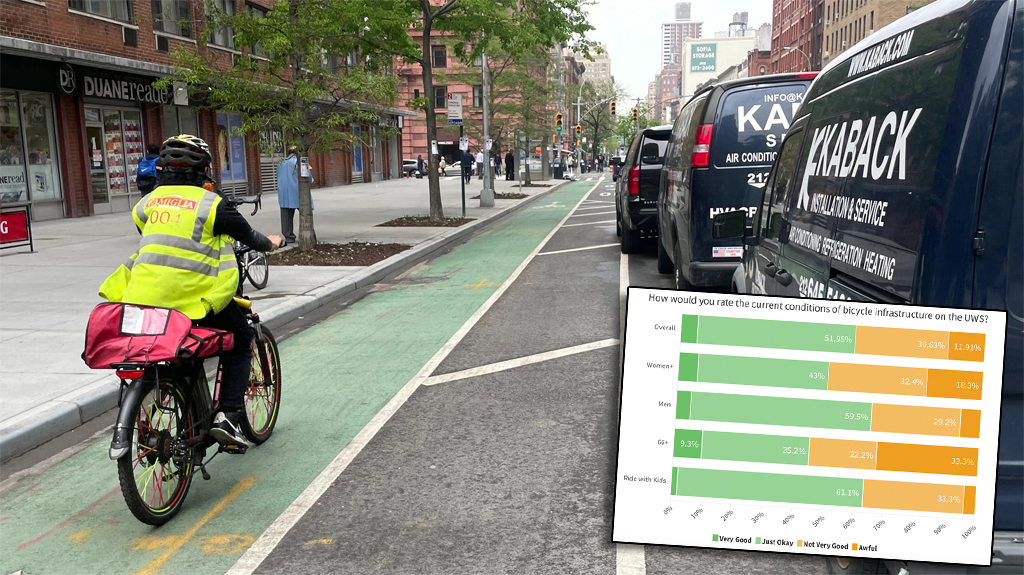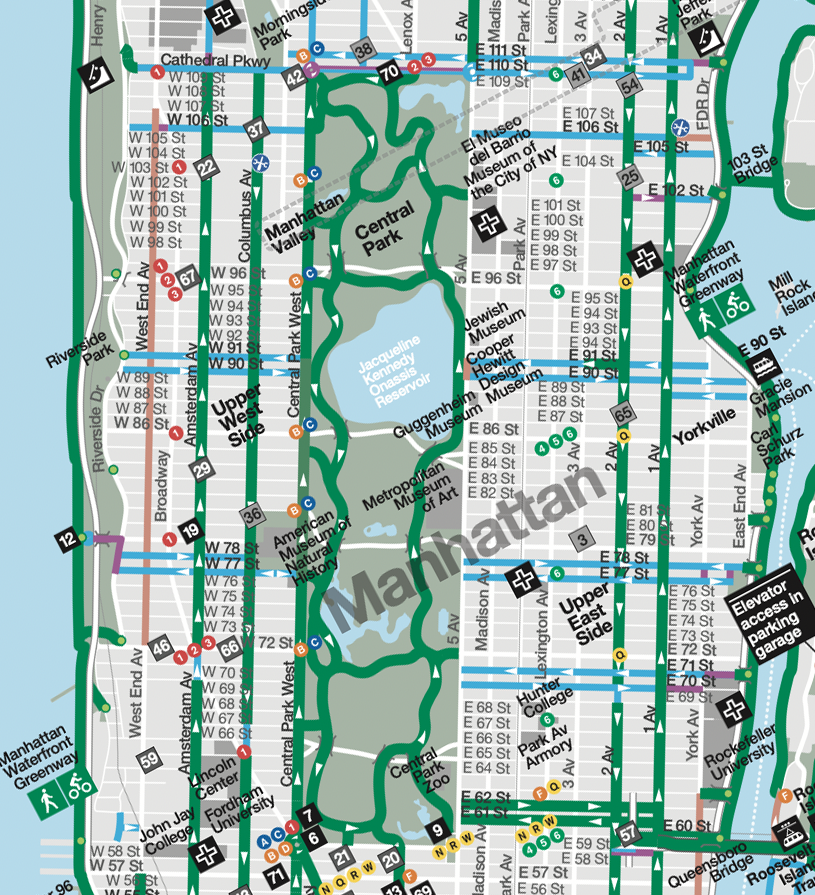You are using an out of date browser. It may not display this or other websites correctly.
You should upgrade or use an alternative browser.
You should upgrade or use an alternative browser.
Eric Adams bikes to work on second day in office: ‘On the road again!’ (A.K.A The NY Bike thread)
- Thread starter bnew
- Start date
More options
Who Replied?NY Daily News - We are currently unavailable in your region
NYC bicyclists facing most lethal year ever with 11 deaths so far in 2023
By Evan Simko-Bednarski
New York Daily News
•
Apr 11, 2023 at 6:31 pm
Spring has barely sprung, yet already 11 cyclists have been killed in New York City this year.
That number puts 2023 on track to be the most lethal for cyclists in recent memory, according to data from the city Department of Transportation.
“The number of fatalities is concerning,” a DOT spokesperson told the Daily News, adding that the department is closely monitoring the data.
:quality(70)/cloudfront-us-east-1.images.arcpublishing.com/tronc/IETSO6MCOVDJ5GL7737TEYJGCE.JPG)
A bicycle after a crash in Brooklyn last August. (Gardiner Anderson/for New York Daily News)
Of the 11 cyclists killed so far this year, seven were riding electric bikes while four were riding traditional bicycles. Four of those killed riding e-bikes died in crashes involving no other vehicles, the department spokesperson said.
The city’s most recent cycling fatality was 16-year-old Jaydan McLaurin, killed Monday night by an SUV driver in a hit-and-run in Astoria, Queens.
McLaurin was struck while riding an electric Citi Bike on 21st St. near the intersection of 21st Ave., police said. Jaydan suffered “severe trauma,” and was pronounced dead at a nearby hospital, said cops.
Yaser Ibrahim, 18, who drove the BMW X7 that hit McLaurin, was charged with leaving the scene of a fatal accident, driving with a tinted windshield, and driving without a license, said police.
Danny Harris, executive director of Transportation Alternatives, called on the city to do more to prevent traffic deaths.
“We’re concerned by the deadly rise in hit-and-runs across the five boroughs — at least three in the past week alone — especially as so many hit-and-runs remain unsolved,” Harris said in a statement.
“Nobody should fear death or serious injury on our streets. No parent should have to worry about whether their child will make it home from a bike ride.”
DOT lists 21st St. in Queens as one of its “priority corridors” — streets or intersections responsible for an outsized share of pedestrian deaths or injuries.
The rise in cycling deaths this early in the year is dramatic.
:quality(70)/cloudfront-us-east-1.images.arcpublishing.com/tronc/KJ6JJVTNC5FMHD7LTZJQP3OY2M.JPG)
The NYPD Highway Patrol investigates after a bicyclist was struck by a minivan on Union Ave. and South 2nd St. in Williamsburg, Brooklyn on January 9. (Gardiner Anderson/for New York Daily News)
According to city data, two cyclists had been killed by this time last year, with a total of 18 cycling deaths in 2022.
In 2021, 19 cyclists were killed — two of them by mid-April.
In 2020, with most New Yorkers indoors due to the COVID-19 pandemic, only one cyclist had been killed by April -- but 25 more died by year’s end.
Electric bikes were classified as motorcycles in city data prior to 2019 — but even when bicycle and motorcycle fatalities are combined, 2023 is the most lethal spring to date since at least 2013, the Transportation Department’s data show..
Monthly data is not available prior to 2013, but yearly fatality statistics kept since 1983 by Transportation Alternatives show 40 cyclists killed in the city in 1999 — the deadliest year for bicycle riders on record."
NYC DOT - Bicycle Maps
www.nyc.gov
BICYCLISTS
Bicycle Maps
New York City Bike Map 2023
Download the NYC Bike Map 2023 (13 MB)
CashmereThoughts
Veteran
These scooters are EVERYWHERE
Elim Garak
Veteran
I figured someone would post this, this needs to be a thread.
doneI figured someone would post this, this needs to be a thread.

'Interested, But Concerned': West Siders Say Safer Bike Lanes Would Get Them Cycling - Streetsblog New York City
A whopping 78 percent of all survey respondents said they'd use micro-mobility devices more with better infrastructure, including seven out of 10 women, four of 10 seniors and 94 percent of parents.
‘Interested, But Concerned’: West Siders Say Safer Bike Lanes Would Get Them Cycling
A whopping 78 percent of all survey respondents said they'd use micro-mobility devices more with better infrastructure, including seven out of 10 women, four of 10 seniors and 94 percent of parents.12:01 AM EDT on June 12, 2023

A delivery worker on the Upper West Side. The neighborhood has several protected lanes — but not enough for many people to feel safe, according to a new survey. File photo: Julianne Cuba
By David Meyer
The Upper West Side has more protected bike infrastructure than most New York City neighborhoods — but still not enough for many of its residents to feel safe biking or using other micro-mobility devices, according to a recent survey.
Streetopia UWS polled Upper West Siders and found that 26.3 percent of people identified as "interested" in using devices like bikes and scooters to get around the neighborhood, but remained "concerned" about being safe.
Concern was highest among women, seniors, and people with kids, with seniors the most likely to say "no way, no how" to urban cycling.
But the survey also showed room for optimism ... albeit with more city effort: A whopping 78 percent of respondents — including seven out of 10 women, four of 10 seniors and 94 percent of parents— said they would use bikes and scooters more if there was better infrastructure.
The Upper West Side has some of the best bike infrastructure in town — thanks to the Hudson River Greenway as well as protected lanes on Central Park West, Amsterdam Avenue, and Columbus Avenue — but its residents still don't perceive the neighborhood as safe: More than half of the survey's respondents called the neighborhood's bike infrastructure "just okay," while 31 percent said it was "not very good" and 12 percent called it "awful."
Only 5.5 percent of residents called the infrastructure "very good."
"My son is a good cyclist, he can bike well, but he's small. He's not nimble, and I wouldn't expect him to be. I would never let him bike in a bike lane adjacent to cars, unprotected by some sort of barrier," said resident Justin Gundlach, a father of a 6-year-old and 10-month-old who contributed to a survey of area bike lane conditions included in the report.
"Even on Columbus and Amsterdam, I'm really wary. I stay close to him when we ride there, and we haven't much," Gundlach said.
Gundlach's wife won't bike in the neighborhood at all, he said.
"Until infrastructure is very different, she's just not going to. We don't go places as a family on bikes because for the most part we can't," the father of two said.

"The infrastructure that's available to us, even though we live in one of the cushiest places in the city for cycling infrastructure, it's actually not that safe. You still get a lot of close calls because of that way things have been designed."
Streetopia UWS recently launched a campaign for crosstown protected lanes; at the moment there are none.
The group may face an uphill battle at Manhattan Community Board 7, whose members have spent the better part of the last 15 years forcing bike advocates through endless procedural hoops to get better infrastructure. A brief period of pro-bike lane peace followed the death of Madison Lyden in 2018, with CB 7 pushing for protected lanes on Central Park West where Lyden died. But the board more recently rejected a Parks Department proposal for an e-bike delivery worker rest stop outside the West 72nd Street subway station.
Manhattan mom Deborah Kerzhner, who lives on W. 111th Street, started biking to work "daily" after the city installed the Central Park West protected bike lane. Kerzhner, her husband, and their three kids have since become a "predominantly biking family," but they still often feel unsafe, she said.

The absence of safe bike lanes means the kids typically ride on the sidewalk — which is legal for them but a nuisance to other pedestrians — while Kerzhner and her husband keep lookout. Her senior citizen parents, who also live in Manhattan, ride often but only in Central Park, Kerzhner said.
"The existence of bike lanes doesn't matter if there's not a network of bike lanes. If any trip I have to take has an unsafe portion, then the whole trip is as safe as its weakest link," Kerzhner said of the area's existing protected lanes.
"Everything is a conflict because my children are not cars. They don't go the speed of cars, they don't travel like cars. They need time, but cars don't want to give them that time. If they have [a protected] lane for themselves, they have that time."
Reluctance to bike among women, seniors, and others is not the exclusive domain of the Upper West Side. The recently released New York Cycling Census found that the lack of safe bike routes to be the "most frequent barrier to cyclist" for nearly three out of four New Yorkers statewide. And while CB7 ranks five of 59 citywide in terms of bike infrastructure, CB9 just to the north ranks 44th.
"Women, seniors, and families encounter the same conditions across the city that make them reluctant to ride in the Upper West Side," said Open Plans Co-Executive Director Sara Lind.
"If those riders feel marginalized, imagine how a curious cyclist in Flatbush feels considering their own, far sparser, mobility options.
4 dead after battery causes fire at New York City e-bike shop that spreads to apartments
Authorities say a fire that started in a New York City e-bike shop spread to upper-floor apartments, killing four people and injuring several others.
4 dead after battery causes fire at New York City e-bike shop that spreads to apartments
2 hours agoNEW YORK (AP) — A fire at a New York City e-bike shop quickly spread to upper-floor apartments and killed four people early Tuesday in the latest deadly blaze linked to exploding lithium ion batteries.
The fire, reported shortly after midnight, happened at a shop that was cited last summer for safety violations related to the storage and charging of batteries, officials said. Investigators determined that it was an accident caused by a lithium ion battery, which can overheat while being charged and explode in an intensely hot flare of flame, fire officials said.
A pile of burned bikes, scooters and other debris lay on the sidewalk outside the shop, HQ E-Bike Repair, which was on the ground floor of a six-story building in Manhattan’s Chinatown neighborhood.
So far this year, there have been more than 100 fires and 13 deaths linked to battery explosions in the city, said Fire Commissioner Laura Kavanagh.
“There was a very large number of both batteries and e-bikes,” Kavanagh said at a morning news conference. “This location is known to the fire department. We have written violations at this location before and we have conducted enforcement at this location before.”
Two men and two women died in Tuesday’s fire. Two other women were hospitalized in critical condition, officials said. A firefighter suffered minor injuries.
Chief Fire Marshal Daniel Flynn said the shop was inspected last August and later cited for safety violations related to battery charging, the number of batteries at the site and the electrical system. The shop was fined $1,600. Authorities recently surveilled the store and found there were many batteries there, but none of them were being charged at the time, he said.
A man who said he was the owner of the bike shop told The Associated Press that he made his usual checks of the store before he left Monday night. He denied that any e-bike batteries were being charged.
“The shop has been there for six years. I check before I leave every night,” said the man, who spoke in Mandarin in a phone interview and only gave his last name, Liu. “I checked last night, turned off the power besides the ones for the monitor and automatic door.”
He added: “I got a call from a neighbor ... and told me about the fire. I went to my shop but couldn’t get close when they were working on the fire. I saw a lot of smoke. My shop is gone. I’ve been working for nothing for years.”
Liu said he was at the police station waiting to talk with officers Tuesday morning.
The blaze startled the neighborhood in the middle of the night.
“A friend of mine came in and yelled ’there’s a fire next door,’” neighborhood resident Belal Alayah told WABC-TV. “I step out. I see the flames so hot it’s going through the metal gate. I knew it was the bike store, so I called the fire department. But the fire kept getting bigger and bigger and it took them a while to stop the fire.”
Electric bikes have become popular, non-gasoline-powered ways to make deliveries, commute and zip around a city that has promoted cycling in recent decades. Many run on lithium ion batteries, which have been blamed for numerous fires.
Last month, an e-bike battery caused a blaze at an apartment building in the Washington Heights section of Manhattan, killing four people including a 94-year-old woman, officials said. In April in the Queens section, two children were killed in a fire blamed on an e-bike battery. Another Manhattan fire in November that injured more than three dozen people was caused by a malfunctioning e-bike battery, officials said.
Last year in the city, nearly 200 fires and six deaths were tied to such batteries, with an 8-year-old girl and a 5-year-old girl among those who died in blazes linked to scooter batteries. Fire officials have repeatedly issued warnings and safety tips, and the city passed new regulations this year aimed at preventing battery fires.
“So we would like to really emphasize today something that we have been saying over and over ... it is also very, very important to get the word out how incredibly dangerous this is,” Kavanagh said. “This exact scenario where there’s an e-bike store on the first floor and residences above and the volume of fire created by these lithium ion batteries is incredibly deadly.”
Lithium ion batteries can catch fire because they contain a flammable electrolyte solution that allows electrical current to flow, experts say. Many fires have been linked to such batteries in laptops, cellphones and other items.
